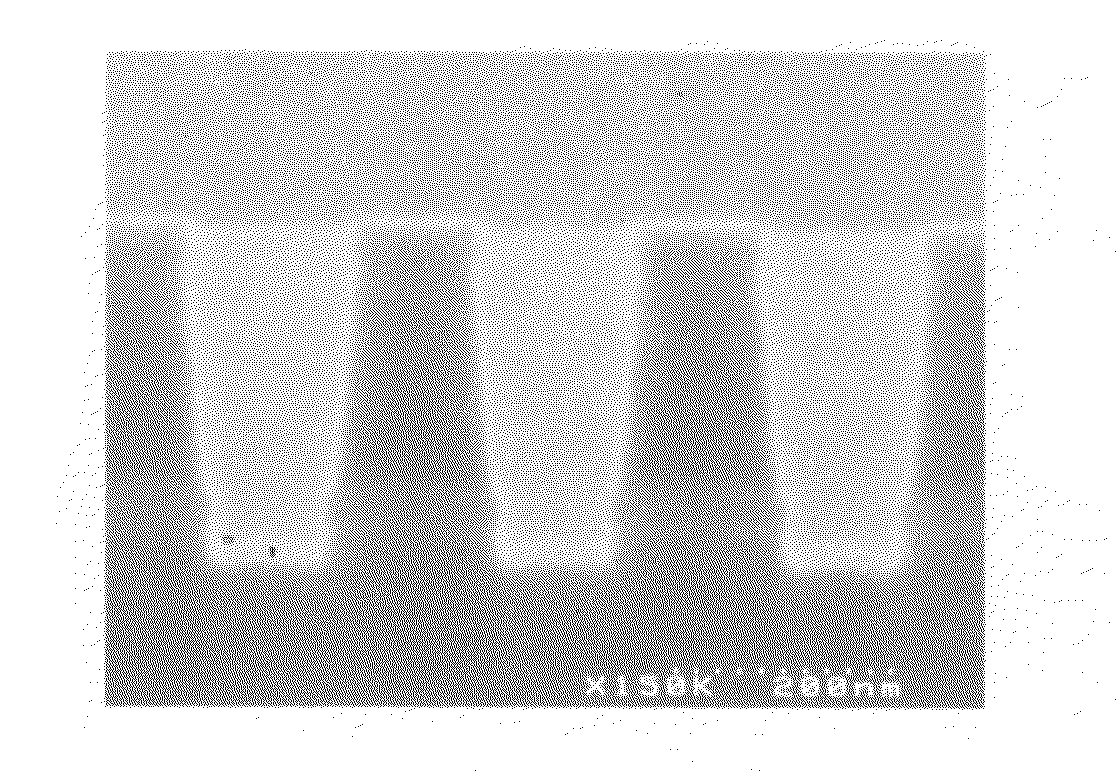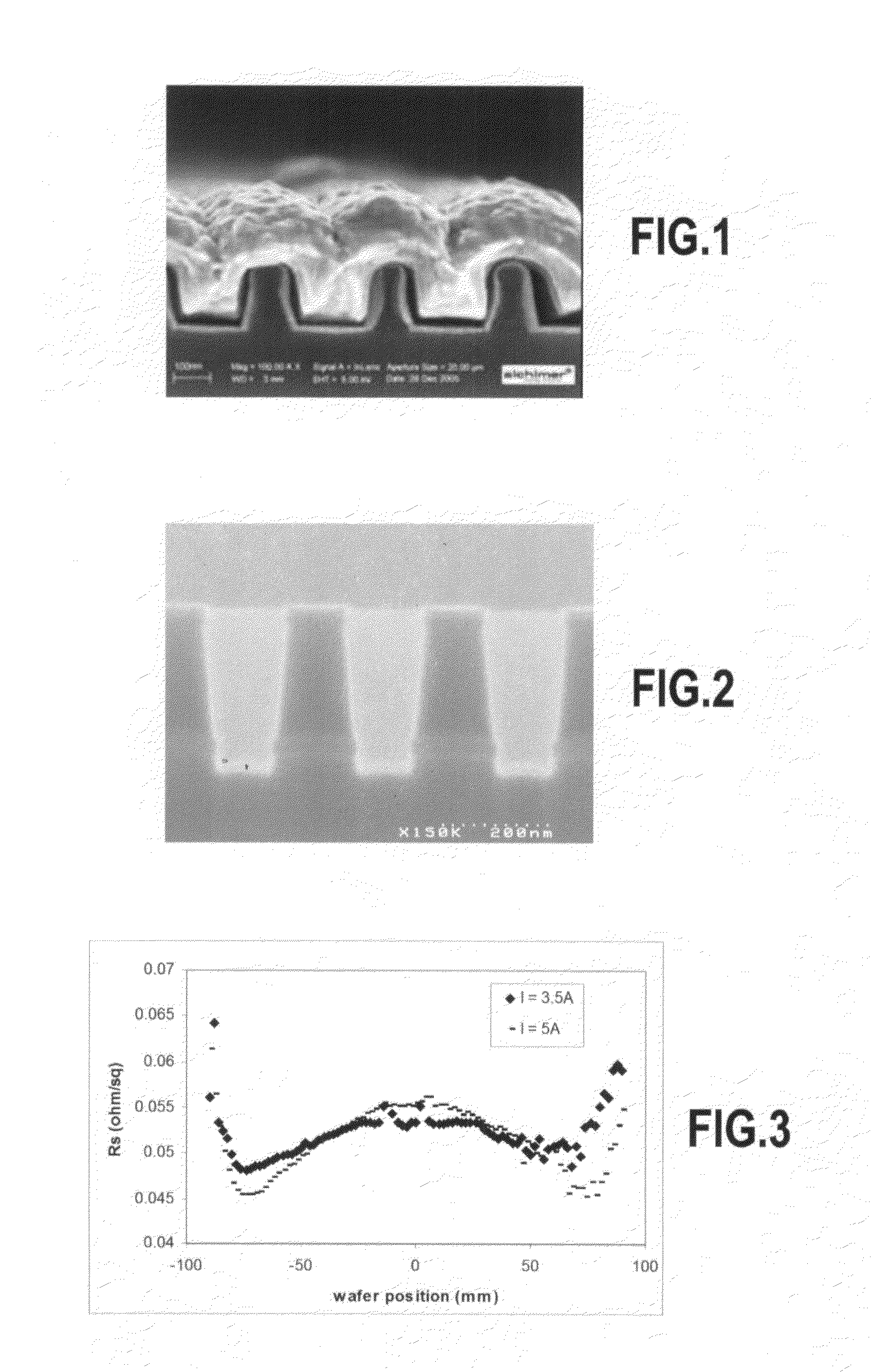Method and compositions for direct copper plating and filing to form interconnects in the fabrication of semiconductor devices
a technology of direct copper plating and semiconductor devices, applied in the direction of tobacco, transportation and packaging, packaging goods types, etc., can solve the problems of insufficient step coverage of pvd techniques, difficulty in filling copper pipes, and inherently directional pvd techniques, etc., to achieve low resistance, strong adhesion, and low resistance
- Summary
- Abstract
- Description
- Claims
- Application Information
AI Technical Summary
Benefits of technology
Problems solved by technology
Method used
Image
Examples
example 1
[0092]The substrate used in this example consisted of a silicon workpiece, coated with a 400 nm layer of silicon dioxide deposited by plasma-enhanced chemical vapor deposition (PECVD). The silicon dioxide layer was coated with a layer of tantalum nitride (TaN) having a thickness of 10 nm deposited by PVD on top of which a layer of tantalum (Ta) having a thickness of 15 nm was also deposited by PVD.
[0093]This TaN / Ta stack is a copper diffusion barrier such as those used in damascene structures. The sheet resistance of this barrier stack was 21 ohm / square.
[0094]A blanket substrate was used for sheet resistance (Rs) measurement by 4-point probe. Adhesion on a blanket substrate was measured by a variable force stud-pull test. A trench-patterned substrate (trench width 200 nm / spacing 100 nm) having the same underlayers as the blanket substrate was used for gap-filling evaluation. Gap fill was observed by scanning electron microscope (SEM) cross-sectional imaging.
[0095]These substrates we...
example 2
[0106]The substrate used in this example consisted of a silicon workpiece, coated with a 400 nm layer of silicon dioxide deposited by plasma-enhanced chemical vapor deposition (PECVD). The silicon dioxide layer was coated with a layer of ruthenium (Ru) having a thickness of 30 nm deposited by PVD. The sheet resistance of this ruthenium layer was 8.5 Ohm / square.
[0107]A blanket substrate was used for sheet resistance (Rs) measurement by 4-point probe. Adhesion on a blanket substrate was measured by a variable force stud-pull test.
[0108]These substrates were used without any pre-treatment.
[0109]The electrolytic copper bath of the invention in this particular example was an aqueous solution containing CuSO4,(H2O)5 with a concentration of 65 mM, and ethylenediamine with a concentration of 160 mM. The pH of this solution was 11.
Equipment
[0110]The cell used for the electrolytic deposit was a glass cell made up of two parts: the cell intended to contain the solution for electrodeposition an...
example 3
[0118]The substrate used in this example consisted of a silicon wafer of diameter 200 mm, coated with a 400 nm layer of silicon dioxide deposited by plasma-enhanced chemical vapor deposition (PECVD). The silicon dioxide layer was coated with a layer of tantalum nitride (TaN) having a thickness of 15 nm deposited by PVD on top of which a layer of tantalum (Ta) having a thickness of 10 nm was also deposited by PVD.
[0119]This TaN / Ta stack is a copper diffusion barrier such as those used in damascene structures. The sheet resistance of this barrier stack was 45 ohm / square.
[0120]A blanket substrate was used for sheet resistance (Rs) measurement by 4-point probe. Adhesion on a blanket substrate was measured by a scotch tape test. A trench-patterned substrate (trench width 200 nm / spacing 100 nm) having the same underlayers as the blanket substrate was used for gap-filling evaluation. Gap fill was observed by focused ion beam (FIB) and SEM cross-sectional imaging.
[0121]These substrates were...
PUM
| Property | Measurement | Unit |
|---|---|---|
| molar ratio | aaaaa | aaaaa |
| molar ratio | aaaaa | aaaaa |
| molar ratio | aaaaa | aaaaa |
Abstract
Description
Claims
Application Information
 Login to View More
Login to View More - R&D
- Intellectual Property
- Life Sciences
- Materials
- Tech Scout
- Unparalleled Data Quality
- Higher Quality Content
- 60% Fewer Hallucinations
Browse by: Latest US Patents, China's latest patents, Technical Efficacy Thesaurus, Application Domain, Technology Topic, Popular Technical Reports.
© 2025 PatSnap. All rights reserved.Legal|Privacy policy|Modern Slavery Act Transparency Statement|Sitemap|About US| Contact US: help@patsnap.com


